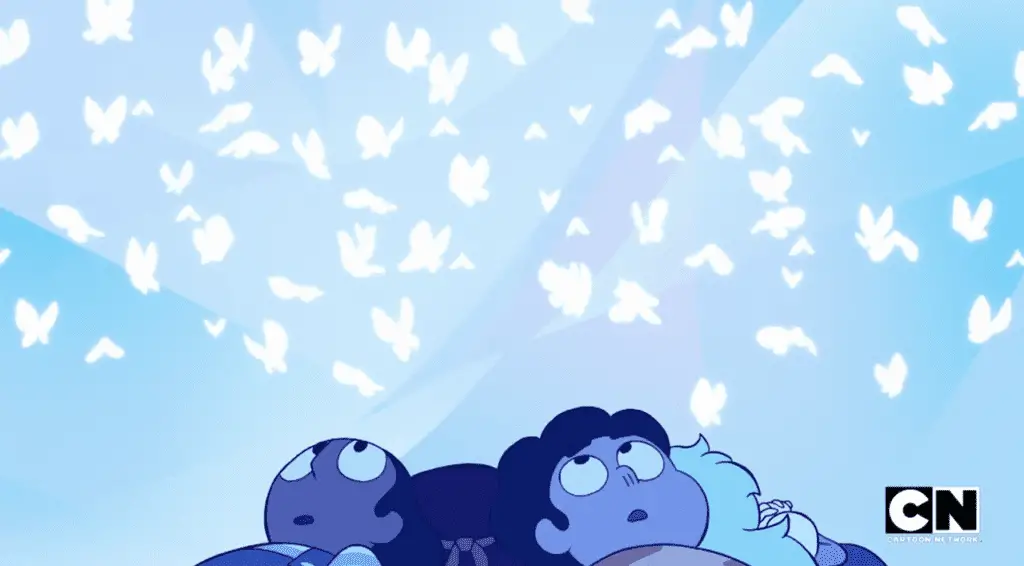We’ve talked before on Fandom Following about the importance of children’s media. We’ve also talked about why Steven Universe is everything (because it is), and why it is the smartest show on television. The recent episode “Mindful Education” is yet one more reason why. It’s a dense, emotionally heavy episode brightened by the chance to listen to Estelle (Garnet) and AJ Michalka (Stevonnie) sing together. As its title suggests, it’s a lesson in mindfulness, teaching children learn how to cope with emotional distress and overwhelming thoughts. And, like all of Steven Universe, it’s moving and complicated and beautiful from beginning to end.
Crafted with Care
When the episode opens, Connie is distracted by something that keeps her from enjoying Steven’s jokes as well as causing Stevonnie to become unstable and unfuse during training.
Connie, we learn, accidentally injured a boy at school and doesn’t know what to do. Steven tries to comfort her by telling her not to think about it, but Garnet interrupts. She’s got a lesson to teach the children about distress management, finding balance, and how to maintain a stable fusion. She also has a song.
(You can find a full transcript of the song here.)
Now, I love all the Steven Universe music. Rebeca Sugar and the Crewniverse are a multi-talented team. “Stronger than You” empowers; “It’s Over (Isn’t it)” makes you weep. The little ditty “Giant Woman” warms your heart. The music always enhances the narrative rather than distracts.
For me, “Here Comes A Thought” went above and beyond. Every part of it is intentional. The lyrics are torn straight out of a cognitive behavioral therapy book but are translated into a language children can grasp. The tune is catchy and melodic and gets stuck in your head. Unlike most of the other full-length songs, “Here Comes A Thought” is highly repetitive. The verses are exactly same except for a shift from second to first person (which is purposeful as well, and I’ll get to that). The chorus and bridges repeat the same phrases.
But it’s not, but it’s not, but it’s not, but it’s not, but it’s not
It’s okay, it’s okay, it’s okay, it’s okay, it’s okay
I’ve got nothing, got nothing, got nothing, got nothing to fear
I’m here, I’m here, I’m here
The simple, easily remembered melody and repetitive lyrics get stuck in your head. It was designed to get stuck in your head. “Here Comes A Thought” is both a song about and an exercise in mindfulness. The episode explains what mindfulness in practice and the song is itself a useful tool that the audience can use for their own distress management. You’re supposed to think of it later, to find yourself singing it while you’re stressed out or upset.
It worked on me. I was singing it to myself days afterward (I still am, to be honest). It just so happened I was out of town when this episode aired visiting family. My family can be stressful, so this episode gave me a tool to help me calm myself down. My headspace distressed me, and my conversations gave way to swarming thoughts. Despite mindfulness being an ongoing practice of mine and having been to therapy for crisis management, it can be hard to remember what to do about distress in the moment. Along came this repetitive, melodic song with easily remembered lyrics I could latch on to, and I did.
The more I listened to it, the more I realized that the entire sequence is intentional. The visual story told while Garnet and Stevonnie sing underscores the message. Ruby’s tears, Sapphire reaching out. Connie’s shock at the huge swarm of thoughts; Steven’s presence by her side. All this paints a picture of the internal experience. It gives a visual representation of what overwhelming thoughts feel like. It’s a picture the audience can relate to and immediately recognize from their own experience.
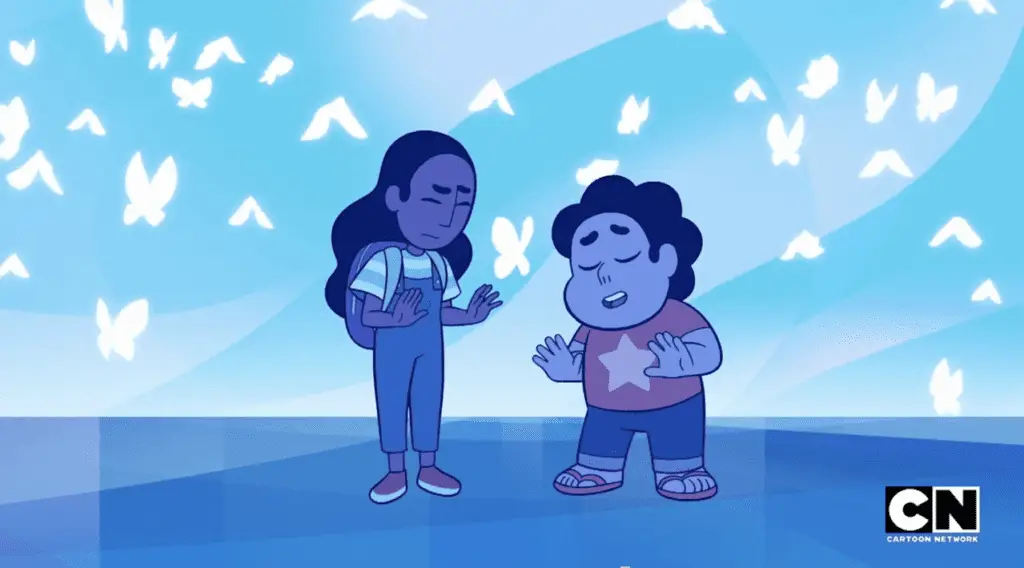
It’s more than a general atmosphere of familiarity. Specific images match the lyrics. There’s a reason why the image of Ruby, Connie, and Steven taking a deep breath accompanies the lyric “It’s okay.” Deep breathing is one of the tools for mindfulness, especially when confronting upsetting or overwhelming experiences. These two things—taking a breath to calm down and reminding yourself that you are okay—mutually reinforce each other visually and in practice.
Speaking of which, there’s a reason why the phrase “it’s okay” is repeated so much. This is a song designed to be remembered, with it’s most useful message the oft repeated refrain. It’s okay. You’re okay. These feelings existing is okay. You need not run from them. Garnet’s introduction to the song—”Here in darkness, everything’s okay. Listen to the waves and let them fade away.”—reinforces the message yet again. If you get nothing else from watching this episode, you’ll come away with the message that “it’s okay” to feel way you do.
And the butterflies. The choice of butterflies to represent thoughts, rather than something like bees or hornets, is intentional as well. Like thoughts, butterflies are both delicate and ephemeral on their own and overwhelming when encountered in swarms. Note that the Crewniverse avoided picturing anything actually frightening. Children ought not to be afraid of their own heads or what goes on in them. That’s why butterflies are such a perfect choice. They’re not something to be afraid of when encountered alone. It’s when they swarm that they get overwhelming.

All told, the Crewniverse took a conceptual experience and gave it life. Connie’s and Ruby’s physical reactions visualize for children what the experience feels like. The song gives them a mental map to coping with it that they can easily remember because of how it was written.
Mindfulness for Self and in Relationships
I mentioned above that the verses differ only in their use of personal pronouns. Garnet sings the first verse in the second person (“Here comes a thought/ That might alarm you/ What someone said/ And how it harmed you”); Stevonnie sings the second verse in the first person (“Here comes a thought/ That might alarm me/ What someone said/ And how it harmed me”).
The choice gives the audience two perspectives on the issue of mindfulness: that of the person who is distressed and of the person trying to help them. The visual story told reinforces this. When Garnet sings, we see Sapphire and Ruby. Ruby is the one distressed by the thought, whatever it is. But we also see that Sapphire is overwhelmed by Ruby’s distressing thoughts and is trying to help Ruby.

Thus, the ‘you’ of the first verse is Ruby; the subject—the ‘I’ of “That I might lose you”—is Sapphire. Sapphire is singing to and about Ruby, attempting to reach out to her. When the song shifts to the second verse, where Stevonnie sings, the subject is Connie. She sings her own experience with her thoughts about hurting Jeff at school as Steven watches her cope.
The context, of course, is fusion, so the dual focus makes sense. This is a song about Connie’s distress, but it isn’t just about Connie. Her distress is affecting more than just her; it’s affecting her relationship with Steven. Garnet sings this song to help teach Connie and Steven how to have a more stable fusion relationship. She explains that imbalance in one member of the fusion can lead to imbalance in the entire fusion, hence “Take a moment to ask yourself/If this is how we fall apart”.
We can’t overlook how important this part of the message of the song is. While on the one hand, it is teaching children about how to be mindful of their own head spaces and cope individually with overwhelming or intrusive thoughts. On the other, this is a song about relationship. It teaches children about how to cope with a distressed friend by helping them to do as Connie and Ruby do. It is about learning how to be the Sapphire and the Steven in this dynamic as well as the Ruby and Connie. Like the moment where Steven and Connie breath together, or when Connie and Steven say “I’m here” to each other in the song.
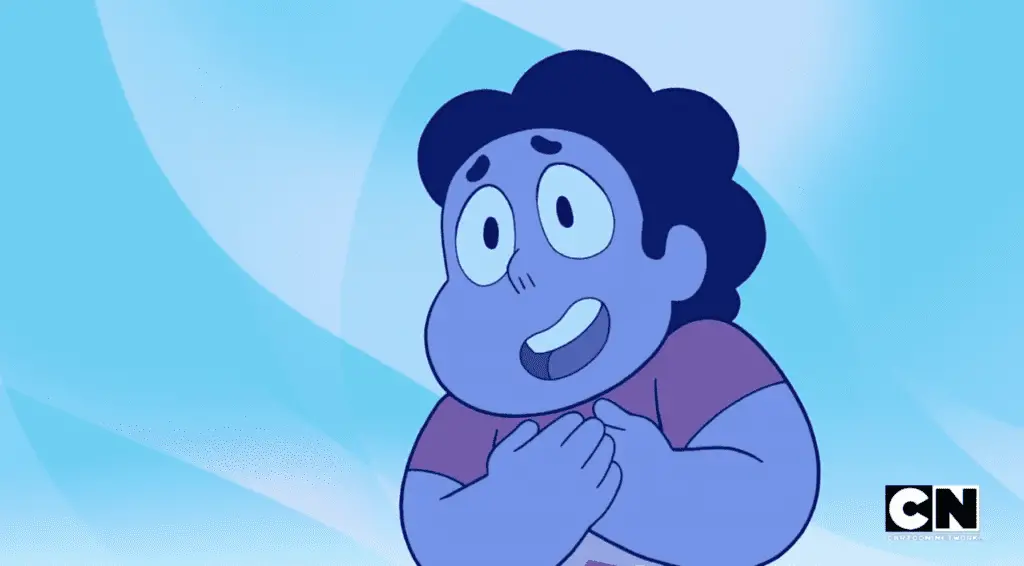
The use of ‘we’ in the lyric “We can watch, we can watch, we can watch, we can watch them go by” underscores this message. In a healthy relationship, the person not under duress learns how to be present with the person who is. Connie and Sapphire cannot change how their partner feels, but they can be present with them and love them through it.
I have to take an aside and talk about how beautiful it is that we get insight into how the Ruby x Sapphire dynamic works. When Garnet talks about seeing one’s feelings and not running from them, she points to her blue eye, to Sapphire. Thus even before the song begins we get the impression that Garnet’s intimate knowledge of mindfulness comes from Sapphire’s influence on Ruby.
Ruby is impetuous, expressive, and driven by strong emotions. Sapphire is controlled, contained, and settled. The difference in their personality can lead to conflict if they’re each coping with the situation differently (see, “Keystone Motel”). But this seems to happen only rarely. “Here Comes A Thought” gives us insight into why Garnet is so stable. Sapphire has helped teach Ruby how to mindfully cope with her distressing thoughts; Ruby has put that into practice in a way that allows them to stay strong together. They’ve found balance in each other through hard work and mutual respect and love.
Sapphire provides insight and balance where Ruby provides a safe outlet for emotion. Similarly, when Steven and Connie work together, they can balance each other. Steven’s unconditional love and upbeat attitude has the potential to balance Connie’s perfectionism and tightly wound, driven personality. This is why Stevonnie makes Garnet so excited.
And then, and then! (Seriously, I have so much to say about this.) I have to talk about the lyric, “Take a moment to ask yourself/ If this is how we fall apart”. This is a serious question for children. Distress in a relationship can lead to total break down. If you’re someone like me who has emotional dysregulation, poor crisis management skills, and grew up in an environment where learning how to manage emotions in a relationship was not modeled well, losing someone because of your personal distress is a real, ever present fear. I grew up believing that I was doomed to push people away because of my emotions and thoughts. For children out there like me, and even those not like me, the song strikes home with all the subtlety of a sledge hammer.
Take a moment, remind yourself to
Take a moment and find yourself
Take a moment to ask yourself
If this is how we fall apart;
But it’s not, but it’s not, but it’s not, but it’s not, but it’s not
It’s okay, it’s okay, it’s okay, it’s okay, it’s okay
I’ve got nothing, got nothing, got nothing, got nothing to fear
I’m here, I’m here, I’m here
I cannot tell you how important this message is. Ruby’s and Connie’s distress need not destroy the relationship. Connie felt guilty over not only hurting Jeff, but over breaking up the fusion. If Garnet had not intervened, it could easily have led to long-term friction in the relationship between Steven and Connie and made Stevonnie far less stable.
This is what Garnet means when she says that imbalance can cause a fusion to ‘lose touch with reality’ and ‘see things that aren’t there’. Eventually, it can become so unstable that it falls apart. Real or perceived hurt can lead to miscommunication, misreading situations, and the breakdown of a relationship. The answer for the distressed person is to see their emotions clearly without running from them. The answer for the unhurt person is to be present with the other rather than running away or ignoring it.
Note also that Garnet does not minimize the experience for either party. “All these little things seem to matter so much/ That they confuse you/ That I might lose you.” “It’s okay” in this context does not mean that the feelings don’t matter. The line is an expression of acceptance and security. That these feelings exist is okay. You don’t have to be afraid of them. The stability of the relationship and person behind them (“Take a moment to think of just/ Flexibility, love, and trust”) makes it possible to see feelings clearly without them swarming. It’s okay. I can handle this. Our relationship can handle this. I’m not going to fall apart. We’re not going to fall apart. I/we can face this together.
A classic mindfulness exercise has the listener imagine their thoughts as train cars in a station. Rather than take time to analyze and experience the thoughts, you take note of them, label, them, and watch them move along. The point is to teach acceptance of thoughts rather than fixation. In other words,
And it was just a thought, just a thought, just a thought, just a thought, just a thought
It’s okay, it’s okay, it’s okay, it’s okay, it’s okay
We can watch, we can watch, we can watch, we can watch them go by
From here, from here, from here
Mindfulness for Connie, mindfulness for children. Mindfulness for self and for relationships. That’s what “Here Comes A Thought” is all about.
A Song for Steven
You’d think this would be enough for Rebecca Sugar and the Crewniverse. You’d think teaching Connie about mindfulness and getting a glimpse into Garnet’s and Stevonnie’s inner life would be enough. But no. The rest of the episode shows us that Steven is not as calm and effervescent as he appears. He too, is avoiding dealing with distressing thoughts. Learning how to heal others, and that some might reject his healing, has taken an emotional toll on him.
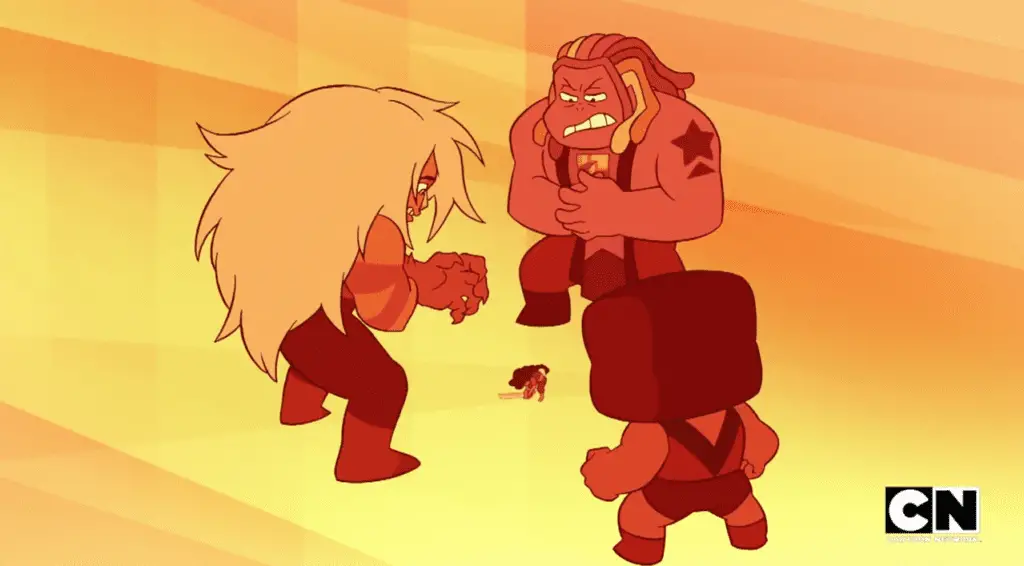
Bismuth, Jasper, Eyeball Ruby—he tried to help them. They wouldn’t listen. He didn’t mean to hurt them, but he did. Steven blames himself for not being able to get through to them. Like Connie, he unintentionally hurt others through no fault of his own. He internalizes their rejection of his help as failure and does not know how to cope with the pain.
That he articulates this to Connie even before Garnet comes to talk to them is proof that he has been stewing on, though really running from, these feelings for a awhile. Unlike Connie, Steven chose to ignore his feelings rather than fixate: “You just have to try not to think about it”. When Steven’s1 thoughts overwhelm Stevonnie and start to destabilize the fusion, they don’t think they can cope. “It’s so much!” Stevonnie cries. Connie reminds Steven that he has to face his feelings. Then comes the gut punch.
Rose. We haven’t gotten much about Steven’s thoughts about his mom. They’re complicated. We know that he believes he won’t be able to live up to her legacy. We know he feels conflicted about her being willing to shatter a gem for the greater good, but is glad to know instead of have it hidden from him. His interactions with Bismuth, Jasper, and Eyeball Ruby have forced him to consider how blurred his identity is with his mother’s, especially for the Homeworld Gems. But this is more reminiscent of popular y8 games and not what is mentioned above.
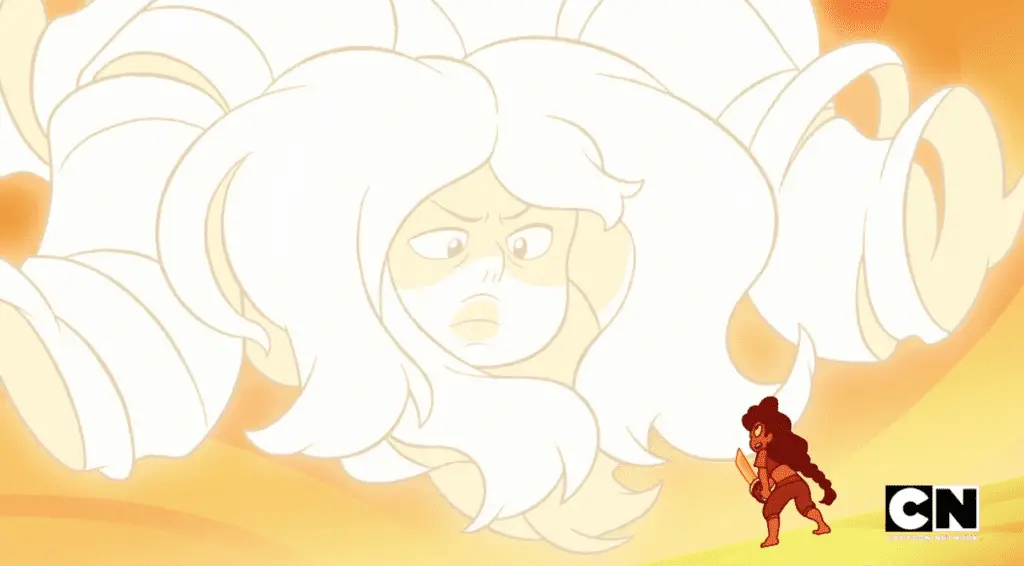
We now know that Steven feels responsible for her death. Why is this the implication? Because of the context. He’s fixated on the people he unintentionally hurt, the ones he couldn’t help but feels responsible for. We know Steven feels that the other Crystal Gems blame him for Rose’s death (1.54, “Joy Ride”), so he’s clearly internalized some guilt over it already. We see now that Steven is stewing about the ones he couldn’t help, the ones he hurt accidentally. Who has that happened to more than Rose? Of course he was a baby and is not responsible for her death.
No matter how frequently the Crystal Gems tell him that Rose made a choice, Steven at some level feels responsible for her death. His very existence is predicated upon her death for his sake. While he did not intend for her to die so that he could exist, she is dead and he is alive. It’s the ultimate act of accidental violence for Steven: matricide.
“And no matter how persuasively anyone tells Steven that his existence was Rose’s willful choice, he will continue to live under the tremendous burden that he came to be only through the forced nonexistence of another person.” —Zach Blumenfeld, “Steven Universe Overcomes The Guilt Of Living In ‘Mindful Education'”
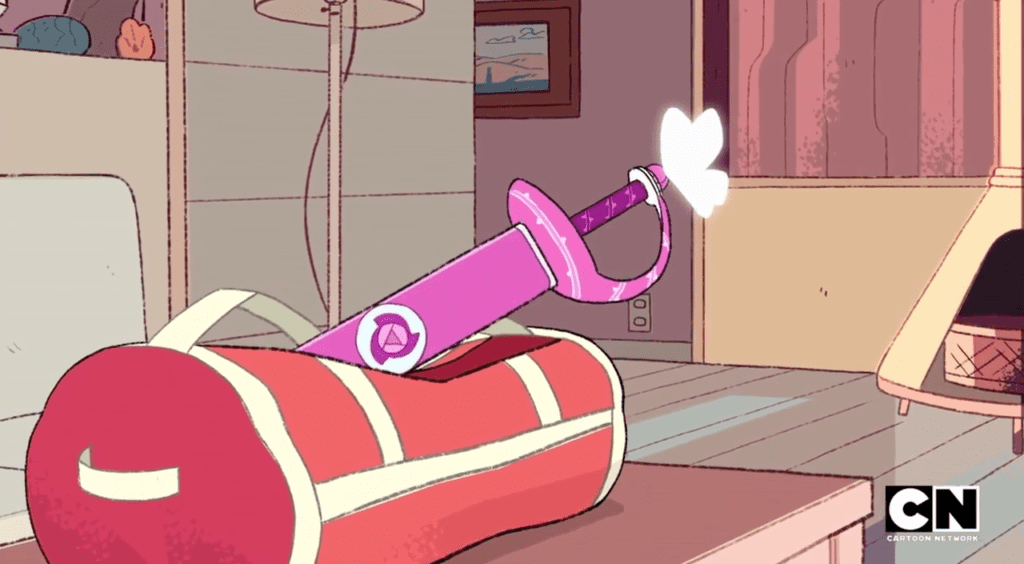
Because that’s it, isn’t it? Steven believes that he only exists because his mother died. Yes, he feels guilty about Jasper and Bismuth and Eyeball Ruby. He worries that he won’t be able to live up to Rose’s legacy, even if he understands her legacy is complicated and dark. Above and beyond all of this is the survivors guilt wrapped up with his mother. He is alive, she is dead, and as far as Steven is concerned, it is his ‘fault’ even if it happened without his agency.
In steps Connie with Garnet’s advice. Since Connie has been able to find calm through facing her thoughts and talking to Jeff, she is able to help Steven. (Proof that Steven can’t face his distress alone, just as Connie and Ruby couldn’t; we need relationships to help us through distress. SO GOOD.). It’s okay to think about it, she says.
Steven: “But it feels so bad!”
Connie: “That’s okay too! There’s nothing else you could have done.”
Steven: “I don’t want to feel this way.”
Connie: “You have to. You have to be honest about how bad it feels so you can move on. That’s how it was for me.”
Steven: *pause* “Okay.”
Excuse me while I go weep in the corner for a while.
Stevonnie’s last words, “I’m here”, when taken in context are more than just an echo of Garnet’s admonishment to mindfulness. Stevonnie exists because Steven exists. The simple phrase echoes the beginning of Steven’s self-acceptance as he moves on from his survivor’s guilt. Steven has chosen to live, and to live not consumed by guilt.
Conclusion
It still blows my mind that Steven Universe can deliver such densely packed episodes. Episodes like this evince just how crafted this show is from beginning to end. “Mindful Education” teaches children about coping with distressing thoughts and grapples with Steven’s existential guilt in the span of eleven minutes. There are no fillers, no fluff episodes (though a few of the beginning episodes lean more in this direction). Everything fits together purposefully and with care. It’s neither too preachy, like a children’s educational program, nor too judgy.
We see concepts like exposure therapy, cognitive behavioral therapy, mindfulness, and radical acceptance being taught in a way that children can understand. They are given a vocabulary to describe their experience and tools to cope with it. Breathing, closing eyes, acceptance, removing value judgments, visualizing internal experience, looking at thoughts from a distance, separating feelings from self—these are all classic tools used in therapy. And they’re being taught to children, children who can now verbalize and visualize their distress in a safe and emotionally distant way. They now know they’re not alone in how they feel and that relationships need not fall apart because of their overwhelming thoughts and emotions.
And all this is done in the context of Connie and Steven working through the emotional distress of hurting someone else. It isn’t just about individuals, but about individuals in relationships: Sapphire and Ruby in Garnet, Steven and Connie in Stevonnie. But it’s bigger than the fusions. Connie and Jeff, Steven and his mother, Steven and Bismuth, Jasper, and Eyeball Ruby. We are a network of relationships that can distress us as well as heal us, but we need not navigate it alone.
Yet, the episode does not minimize the distress of accidentally hurting other people. Connie may have broken someone’s arm (or sprained it, we don’t exactly know), and Steven feels guilty for existing. Connie must accept responsibility for accidentally hurting someone, ask forgiveness, and move on. Steven has to accept that he is alive and live his life rather than focus on his mother’s death. Acknowledging these feelings doesn’t change them or minimize the pain. But it allows them both (and us) to move on in a healthy way. To live and not be consumed by our distress.
Connie put it best:
“I spent all that time feeling bad instead of doing something. It’s like, I was trying not to think about it, and that just made it worse.”
That’s a lesson we can all learn, no matter how old we are.
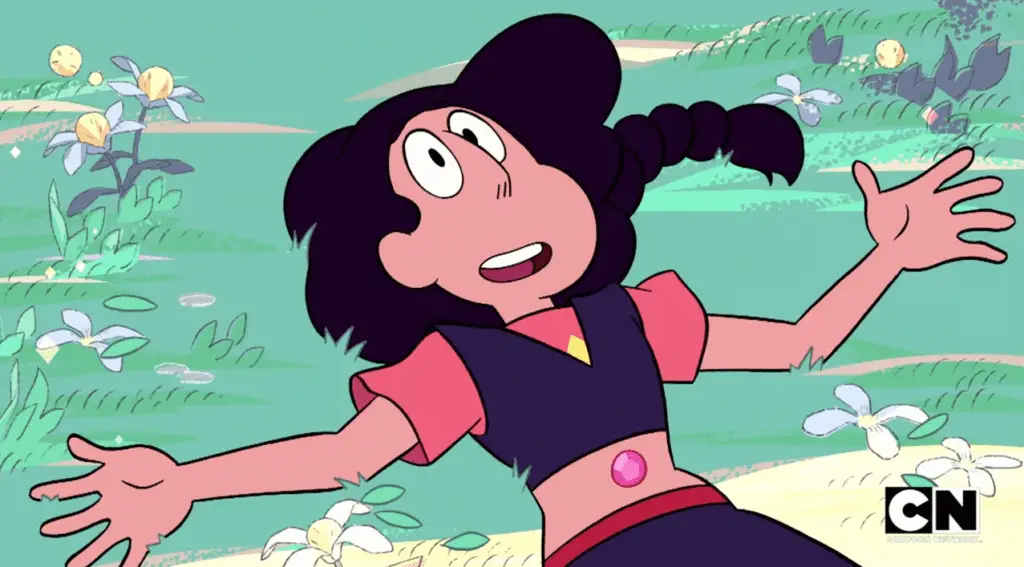
Images courtesy of Cartoon Network
1. Using pronouns when talking about Stevonnie can be complicated. Stevonnie as an individual is non-binary, so they/them is expected. When Stevonnie is talking to themselves and you can tell which personality is dominant, the situation is more complicated. I have tried to use they/them whenever possible and make it clear when I can see whether Steven or Connie is talking to the other as Stevonnie.↩


